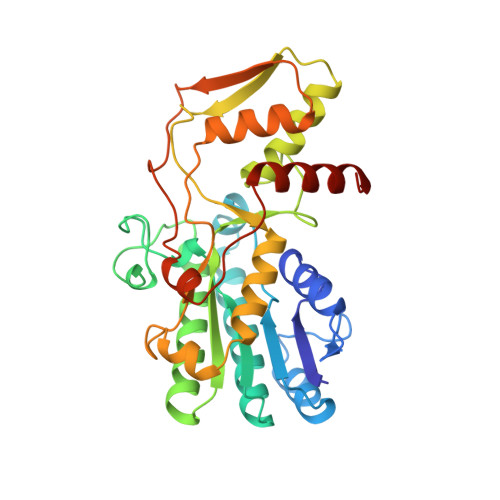GDP-4-keto-6-deoxy-D-mannose epimerase/reductase from Escherichia coli, a key enzyme in the biosynthesis of GDP-L-fucose, displays the structural characteristics of the RED protein homology superfamily.
Rizzi, M., Tonetti, M., Vigevani, P., Sturla, L., Bisso, A., Flora, A.D., Bordo, D., Bolognesi, M.(1998) Structure 6: 1453-1465
- PubMed: 9817848
- DOI: https://doi.org/10.1016/s0969-2126(98)00144-0
- Primary Citation of Related Structures:
1BWS - PubMed Abstract:
The process of guanosine 5'-diphosphate L-fucose (GDP-L-fucose) biosynthesis is conserved throughout evolution from prokaryotes to man. In animals, GDP-L-fucose is the substrate of fucosyltransferases that participate in the biosynthesis and remodeling of glycoconjugates, including ABH blood group and Lewis-system antigens. The 'de novo' pathway of GDP-L-fucose biosynthesis from GDP-D-mannose involves a GDP-D-mannose 4,6 dehydratase (GMD) and a GDP-4-keto-6-deoxy-D-mannose epimerase/reductase (GMER). Neither of the catalytic mechanisms nor the three-dimensional structures of the two enzymes has been elucidated yet. The severe leukocyte adhesion deficiency (LAD) type II genetic syndrome is known to result from deficiencies in this de novo pathway. The crystal structures of apo- and holo-GMER have been determined at 2.1 A and 2.2 A resolution, respectively. Each subunit of the homodimeric (2 x 34 kDa) enzyme is composed of two domains. The N-terminal domain, a six-stranded Rossmann fold, binds NADP+; the C-terminal domain (about 100 residues) displays an alpha/beta topology. NADP+ interacts with residues Arg12 and Arg36 at the adenylic ribose phosphate; moreover, a protein loop based on the Gly-X-X-Gly-X-X-Gly motif (where X is any amino acid) stabilizes binding of the coenzyme diphosphate bridge. The nicotinamide and the connected ribose ring are located close to residues Ser107, Tyr136 and Lys140, the putative GMER active-site center. The GMER fold is reminiscent of that observed for UDP-galactose epimerase (UGE) from Escherichia coli. Consideration of the enzyme fold and of its main structural features allows assignment of GMER to the reductase-epimerase-dehydrogenase (RED) enzyme homology superfamily, to which short-chain dehydrogenase/reductases (SDRs) also belong. The location of the NADP+ nicotinamide ring at an interdomain cleft is compatible with substrate binding in the C-terminal domain.
- Dipartimento di Scienza e Tecnologia del Farmaco Universitá del Piemonte Orientale "A.Avogadro" Viale Ferrucci 33-28100 Novara, Italy.
Organizational Affiliation:

















